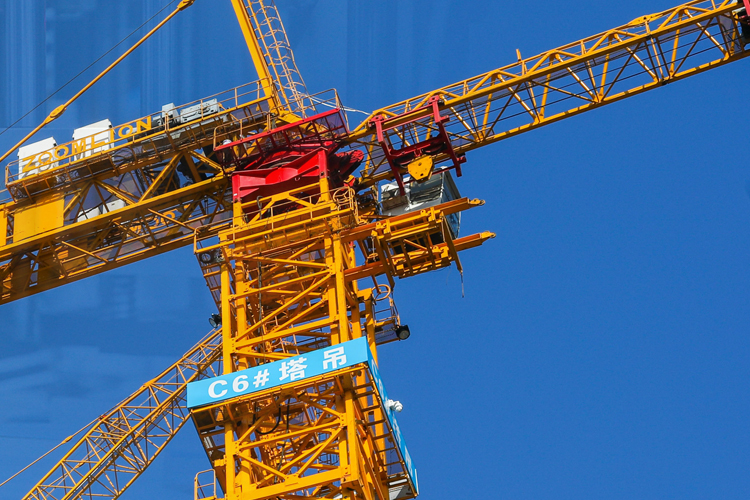1. Overview
Tower crane is the hoisting machinery widely used on construction sites. The traditional control methods are mostly using AC winding motor string resistance to start and adjust speed. Due to long-term heavy load operation, frequent forward and reverse rotations, high impact current, and harsh working environment in some occasions, the slip ring, carbon brush and contactor of the motor are often damaged, the contact of the contactor burns, the carbon brush fires, and motors and resistors are burnt out from time to time. For the circuit is complicated, the bearings of the slewing mechanism often need to be replaced. Because the main hoisting mechanism is mostly operated by two motors on one shaft, the high-speed motor is in the working state, and the low-speed motor is in the braking state, thus always being in contradiction. The mechanical shock is large when switching from fast to slow speed, and the phenomenon of gear collision often occurs. It has happened that the goods have been located and the operator has held the rope, and when switched from fast to slow speed. the gear is broken, and the brake of the slow motor failed, which is very dangerous. Occasionally, the phenomenon of broken shafts may occur. The failure rate is high, exerting a great impact on production, and the cost for repair and maintenance are also expensive.
Because asynchronous motors have unparalleled advantages: simple and firm structure, low price, and easy to maintain, the use of inverter to drive three-phase asynchronous motor control mode instead of traditional speed regulation can fundamentally solve the problem of high crane failure rate. It is an ideal transmission control device for tower cranes because of its advanced technology and significant energy saving.
II. Working principle
1. Crane operating mechanism: It is used to drag the entire crane to make a "horizontal" movement along the construction site, composed of electric motors, brakes, deceleration devices and wheels;
2. Trolley operating mechanism: It is used to drag hooks and heavy objects along the bridge to make "vertical" movement, also composed of electric motors, brakes, deceleration devices and wheels;
3. Lifting mechanism: It is used to drag heavy objects to make upward or downward lifting motion. It consists of a motor, a deceleration device, a reel and a brake. Large cranes (over 10 tons) have two lifting mechanisms: "main hook" and "secondary hook". Generally, "main hook" and "secondary hook" cannot lift goods at the same time;
4. Slewing mechanism: It is used to drag the bridge arm to rotate around the shaft. In order to avoid wandering, it is usually composed of dual motors, deceleration mechanism and brake.
III. Technical requirements for tower crane frequency inverter
1. Safe and reliable operation of tower crane;
2. It can realize forward and reverse rotation, multi-speed operation, external reset of frequency inverter failure, and emergency shutdown of the frequency converter to ensure safety;
3. Start and stop failure of frequency inverter to ensure the effective action of the mechanical brake to ensure the safe operation of the equipment;
4. Adopt YX8000 series inverter.
IV. Parameter setting of frequency inverter
Function
code
Name
Setting
value
Setting
value
Setting
value
Remarks
Crane/trolley
Rotation
Main
hook
Only
use main hook
P0.00
Frequency setting channel selection
5
Multi-speed running setting
P0.02
Run command channel selection
1
Terminal command
P0.04
Control mode
0
Vector control without PG
P0.10
Acceleration time 1
1.5S
unit (s)
P0.11
Deceleration time 1
2S
unit (s)
P0.15
Torque boost
10
%
P2.01
Starting frequency
3HZ
unit (HZ)
P3.08
Multi-speed 0
10
%
Customer demand
P3.09
Multi-speed 1
40
P3.11
Multi-speed 3
60
P3.15
Multi-speed 7
80
P4.34
Multi-speed
14
50
HZ
P6.00
X1 terminal function selection
1
Forward running
P6.01
X2 terminal function selection
2
Reverse running
P6.02
X3 terminal function selection
7
Fault reset
P6.03
X4 terminal function selection
12
Multi-speed 1
P6.04
X5 terminal function selection
13
Multi-speed 2
P6.05
X6 terminal function selection
14
Multi-speed 3
P6.06
X7 terminal function selection
25
Multi-speed 4
P6.12
Relay (RA RB RC) output selection
4
Frequency level detection FDT output
P6.13
Relay (TA TB TC) output selection
3
fault output
P6.19
Frequency detection value (FDT level)
4HZ
This parameter is adjusted according to site
conditions (for reference only)
P8.00
Motor parameter self-learning
2
This parameter is adjusted according to site
conditions
P8.01
Motor power
P8.02
Motor rated speed
P8.03
Motor rated current































